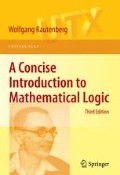Abstract
Model theory is a main branch of applied mathematical logic. Here the techniques developed in mathematical logic are combined with construction methods of other areas (such as algebra and analysis) to their mutual benefit. The following demonstrations can provide only a first glimpse in this respect, a deeper understanding being gained, for instance, from [CK] or [Ho]. For further-ranging topics, such as saturated models, stability theory, and the model theory of languages other than first-order, we refer to the special literature, [Bue], [Mar], [Pz], [Rot], [Sa], [She].
The theorems of Lwenheim and Skolem were first formulated in the generality given in 5.1 by Tarski. These and the compactness theorem form the basis of model theory, a now wide-ranging discipline that arose around 1950. Key concepts of model theory are elementary equivalence and elementary extension. These not only are interesting in themselves but also have multiple applications to model constructions in set theory, nonstandard analysis, algebra, geometry and elsewhere.
Access this chapter
Tax calculation will be finalised at checkout
Purchases are for personal use only
Notes
- 1.
All these conditions are also equivalent (they all hold) if the inconsistent theory is taken to be complete, which is not the case here, as we agreed upon in 3.3.
- 2.
This assumption is equivalent to the assertion that \(\{\gamma {\in }^{\langle X\rangle }\mid \mathcal{A}\vDash \gamma \}\) is complete; see the subsequent proof. For refinements of the theorem we refer to [HR].
- 3.
The “distance” d(a, b) between elements a, b of some SO-model is 0 for a = b, 1 + the number of elements between a and b if it is finite, and d(a, b) = ∞ otherwise.
- 4.
Moreover, the theory of all linear orders is decidable (Ehrenfeucht), and thus each of its finite extensions; but the proof is incomparably more difficult than for DO or SO.
- 5.
For uncountable \(\mathcal{A}\) we have \(\vert \mathcal{L}A\vert = \vert \mathcal{A}\vert \). In this case one proceeds with an ordinal enumeration of \(\mathcal{L}A\) rather than an ordinary one. But the proof is almost the same.
References
C. C. Chang, H. J. Keisler, Model Theory, Amsterdam 1973, 3⟨{ rd}⟩ ed. North-Holland 1990.
W. Hodges, Model Theory, Cambridge Univ. Press 1993.
S. Buechler, Essential Stability Theory, Springer 1996.
D. Marker, Model Theory, An Introduction, Springer 2002.
B. Poizat, A Course in Model Theory, Springer 2000.
P. Rothmaler, Introduction to Model Theory, Gordon & Breach 2000.
G. Sacks, Saturated Model Theory, W. A. Benjamin 1972.
S. Shelah, Classification Theory and the Number of Nonisomorphic Models, Amsterdam 1978, 2⟨{ nd}⟩ ed. North-Holland 1990.
O. Deiser, Axiomatische Mengenlehre, Springer, to appear 2010.
K. Kunen, Set Theory, An Introduction to Independence Proofs, North-Holland 1980.
H. Herre, W. Rautenberg, Das Basistheorem und einige Anwendungen in der Modelltheorie, Wiss. Z. Humboldt-Univ., Math. Nat. R. 19 (1970), 579–583.
R. McKenzie, M. Valeriote, The Structure of Decidable Locally Finite Varieties, Progress in Mathematics 79, Birkhuser 1989.
B. L. van der Waerden, Algebra I, Berlin 1930, 4⟨{ th}⟩ ed. Springer 1955.
M. Ziegler, Model theory of modules, Ann. Pure Appl. Logic 26 (1984), 149–213.
M. Presburger, Über die Vollständigkeit eines gewissen Systems der Arithmetik ganzer Zahlen, in welchem die Addition als einzige Operation hervortritt, Congrès des Mathématiciens des Pays Slaves 1 (1930), 92–101.
A. Wilkie, Model completeness results for expansions of the ordered field of real numbers by restricted Pfaffian functions and the exponential function, Journal Amer. Math. Soc. 9 (1996), 1051–1094.
M. Davis (editor), The Undecidable, Raven Press 1965.
A. Robinson, Introduction to Model Theory and to the Metamathematics of Algebra, Amsterdam 1963, 2⟨{ nd}⟩ ed. North-Holland 1974.
B. L. van der Waerden, Algebra I, Berlin 1930, 4⟨{ th}⟩ ed. Springer 1955.
_________ , A Decision Method for Elementary Algebra and Geometry, Santa Monica 1948, Berkeley 1951, Paris 1967.
Author information
Authors and Affiliations
Corresponding author
Rights and permissions
Copyright information
© 2010 Springer Science+Business Media, LLC
About this chapter
Cite this chapter
Rautenberg, W. (2010). Elements of Model Theory. In: A Concise Introduction to Mathematical Logic. Universitext. Springer, New York, NY. https://doi.org/10.1007/978-1-4419-1221-3_5
Download citation
DOI: https://doi.org/10.1007/978-1-4419-1221-3_5
Published:
Publisher Name: Springer, New York, NY
Print ISBN: 978-1-4419-1220-6
Online ISBN: 978-1-4419-1221-3
eBook Packages: Mathematics and StatisticsMathematics and Statistics (R0)

